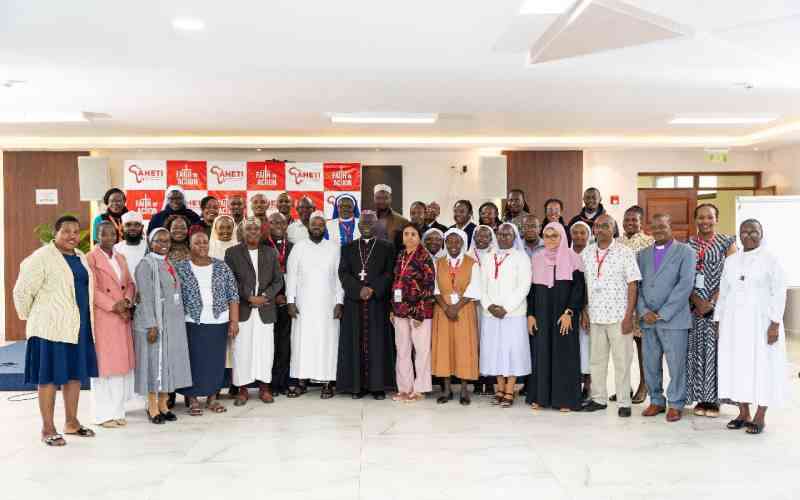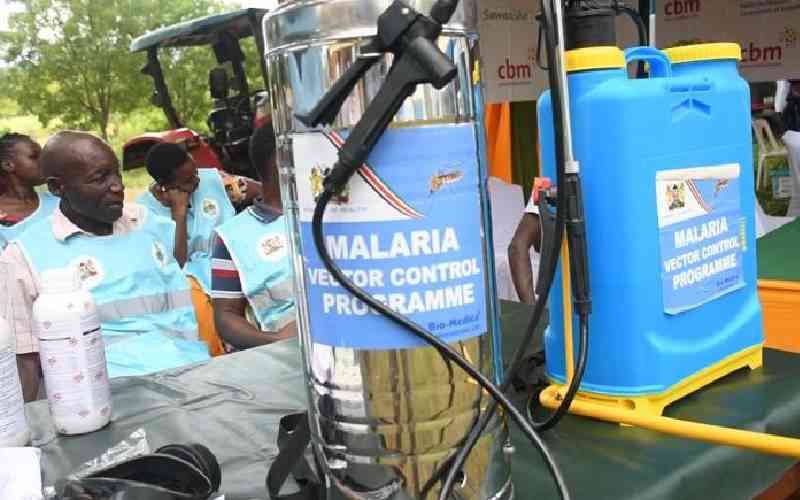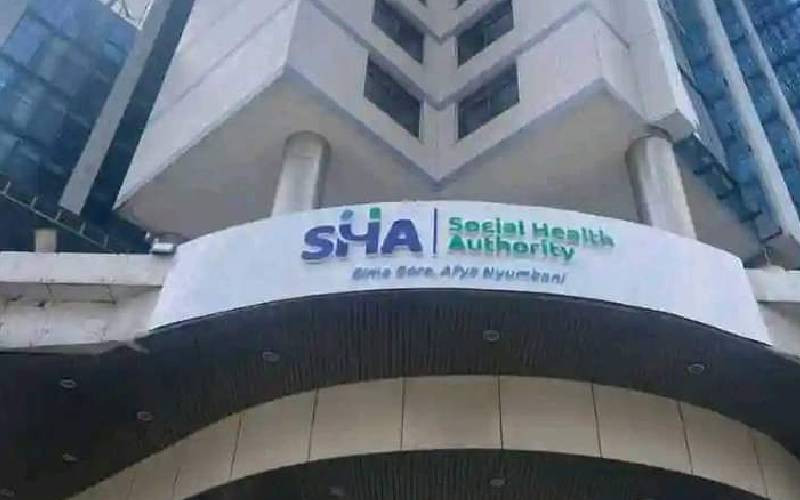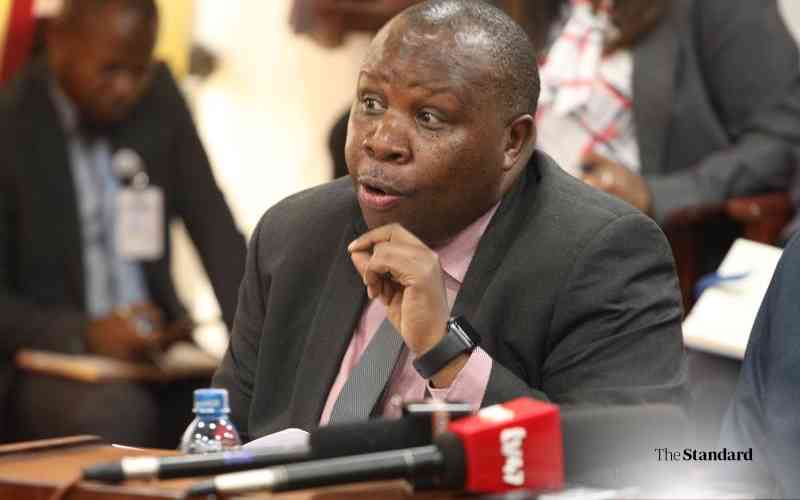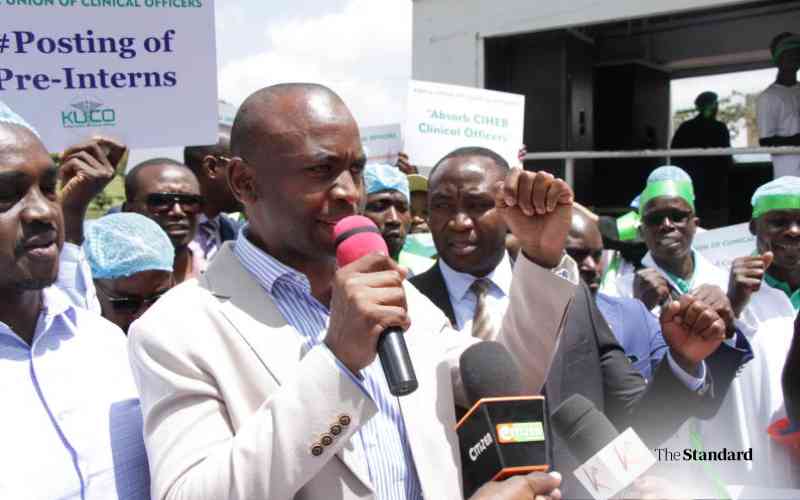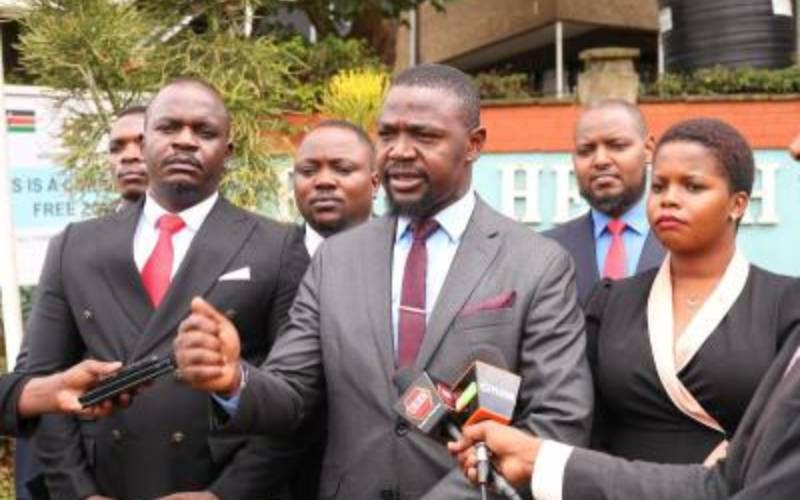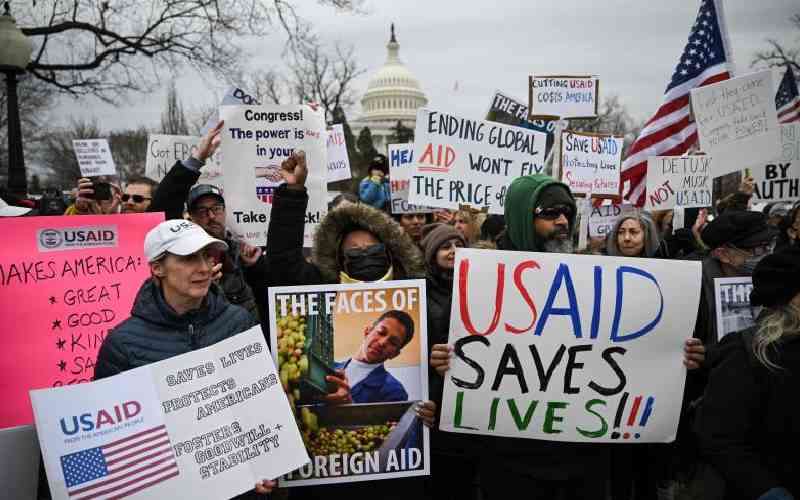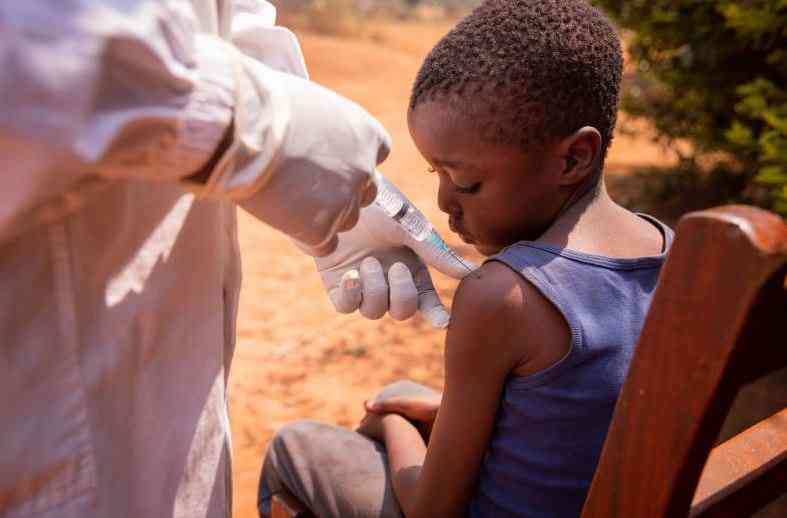
Community health promoters at Mwembe Kati village in Chonyi during World Maria Day celebrations, on April 26, 2025. The 720 community health volunteers have undergone training for larvae source management programme, geared to fight malaria. [Marion Kithi, Standard]
Turkana has been classified as a malaria endemic county in the latest survey by the National Malaria Control Programme.
Previously, malaria in the county was mostly witnessed during the rainy season.
The county now joins endemic counties of Busia, Kakamega, Kisumu, Migori, Siaya and Vihiga that are exhibiting high cases of the mosquito-borne disease.
“The malaria burden in Turkana County has transitioned from a largely seasonal to a stable endemic region,” reads a section of the report.
Despite a shift in classification of the disease, the report notes that there are regions within the country that exhibit seasonality of malaria.
“Assessments by the National Malaria Control Programme, County Government of Turkana, Moi, and Duke Universities revealed that Turkana reports a more than 65 per cent increase in malaria cases during the rainy season, thus making a case for seasonal malaria chemoprevention (SMC),” adds the report.
- Children grapple with pain, bow legs linked to Lake Turkana
- Health CS Barasa says government assessing impact of US aid withdrawal
- Kenya explores local funding for health as Trump regime dithers on funding freeze
- UN decries 'state of confusion' over Trump funding freeze
Keep Reading
SMC is a highly effective intervention to prevent malaria infection during the peak transmission period among those most at risk, such as children under five years.
In 2024, the initial phase of SMC targeted Turkana Central Sub-county, which had recorded 102,000 cases in 2024, with about 60 per cent occurring between May and September.
SMC was rolled out in June 2024 with support from the Catholic Relief Services.
The exercise targeted 38,585 under-five children to be administered with the combination sulfadoxine-pyrimethamine and amodiaquine (SP+AQ), to prevent malaria episodes in the target population during the peak transmission season.
Five monthly cycles of drug administration were done, each separated by 28-days.
During the study, 71 per cent of children (27, 206 children) of the targeted children managed to take the medication in all the five cycles.
In 2025, the second round of SMC in Turkana Central will be done from June and will adopt a digital campaign approach based on the eCHIS platform.
The results from the two rounds, 2024 and 2025, will inform expansion and implementation approaches for effective deployment and impactful outcomes of the intervention.
Though contributors to high cases of malaria were not stated, Turkana is among counties where new mosquito species-anopheles stephansi has spread since its discovery in Kenya in 2023.
The mosquito species was first discovered in Marsabit, and continues to spread across the country, risking infections of more cases of malaria, a leading killer disease in Kenya.
Apart from Turkana and Marsabit, the species has been detected in Mandera and Samburu, which experts say poses a threat to the elimination of malaria.
Unlike the traditional malaria causing mosquito namely anopheles gambie and anopheles funfest, anopheles stephansi is not only invasive and can spread malaria very fast to new areas. It is also adaptive to different climatic and environmental conditions.
The former Health Cabinet Secretary Susan Nakhumicha told the National Assembly Health Committee in 2023, that Marsabit, considered to be malaria free, confirmed at least 3,329 malaria cases.
Kenya became the sixth country to detect the mosquito known as the biggest malaria vector in Asia.
The mosquito species has also detected in Djibouti, Ethiopia, Sudan, Somalia, and Nigeria.
Invasion of the mosquito species to the African continent may put an additional 126 million people at risk of malaria each year, with children and expectant mothers being expected to account for the bulk of the cases.
The Ministry of Health maintains that malaria remains a significant public health and socioeconomic problem in Kenya.
In 2023, Kenya reported about 5.5 million malaria cases, translating to 104 cases per a population of 1,000.
Of the cases, at least 1,097,883 were treated at the community level by Community Health Promoters (CHPs), accounting for two out of 10, of all the cases.
Six counties with high burden of malaria include Busia, Kakamega, Kisumu, Migori, Siaya, and Vihiga, with an average adjusted incidence of 748 malaria cases per 1,000 people, while high-burden counties, including Bungoma, Homa Bay, Kwale, Turkana, and West Pokot at 474 cases per 1000.
“The top 10 counties with the highest malaria burden accounted for 4,900,664 cases, representing 90.3 per cent of all cases in Kenya. These counties are Siaya, Busia, Kakamega, Migori, Kisumu, Homa Bay, Bungoma, Turkana, Vihiga and Kwale,” adds the report.
Notably, Busia, Siaya, Kakamega, and Migori alone contributed 53.2 per cent of all malaria cases in the country, underscoring the need for intensified interventions in these regions.
To eliminate the cases, several interventions have been implemented, including the distribution of insecticide-treated nets (ITNs) to households, indoor residual spraying, Malaria Case Management with emphasis on prompt diagnosis and effective treatment through improved access, including at the community level.
“In conjunction with the distribution of nets, indoor residual spraying is a core prevention intervention and is currently being implemented in Migori and Busia Counties with support from the United States Government through the President’s Malaria Initiative (PMI),” adds the report.
The intervention targets high-transmission areas by applying insecticides in the interior surfaces of households and especially sleeping spaces, to effectively reduce mosquito populations and interrupt malaria transmission.
In 2024, the indoor residual spraying was conducted in Busia and Migori from March to May.
A total of 423,037 structures were sprayed, out of 444,890 eligible structures.
The achievement of the campaign was above the WHO effectiveness coverage of 85 percent, Busia County achieved 95.1 percent, while Migori achieved 95.0 percent. Conferring protection to about 2 million persons.
However, the campaign has not yet started in other areas due to pending American policy directives following the stop world order signed by President Donald Trump.
“While the insecticide is already available in the country, the program is still awaiting permission from USAID to proceed with its use,” notes the ministry.
The report comes at a time when Kenya’s malaria control efforts are under strain, following a freeze on donor support triggered by a "stop work" order signed by former U.S. President Donald Trump.
Malaria elimination efforts in Kenya are heavily supported by the US Government through the President’s Malaria Initiative (PMI).
Public Health and Professional Standards PS Mary Muthoni noted Kenya's significant strides in the fight against malaria prevalence over the years.
According to the new report, 84 people out of 1000 are testing for the disease as opposed 112 in 2016.
However, Muthoni warns that this trajectory may change as the USAID funding cuts affect the health sector.
Elimination of malaria programme in endemic counties is supported by the U.S. Government through the President's Malaria Initiative (PMI)
"In as much as the malaria numbers have been fluctuating, unless there is more investment from the two levels of Government, then there is a risk of the prevalence going up again," said Muthoni.
As the world celebrates world malaria day, Kenya prides itself as having made milestones in combating the malaria pandemic as 21 counties remain on the path of eradicating it.
Muthoni now calls for concerted efforts that include more investment in health so as not to reverse the gains made this far.
 The Standard Group Plc is a multi-media organization with investments in media platforms spanning newspaper print
operations, television, radio broadcasting, digital and online services. The Standard Group is recognized as a
leading multi-media house in Kenya with a key influence in matters of national and international interest.
The Standard Group Plc is a multi-media organization with investments in media platforms spanning newspaper print
operations, television, radio broadcasting, digital and online services. The Standard Group is recognized as a
leading multi-media house in Kenya with a key influence in matters of national and international interest.

